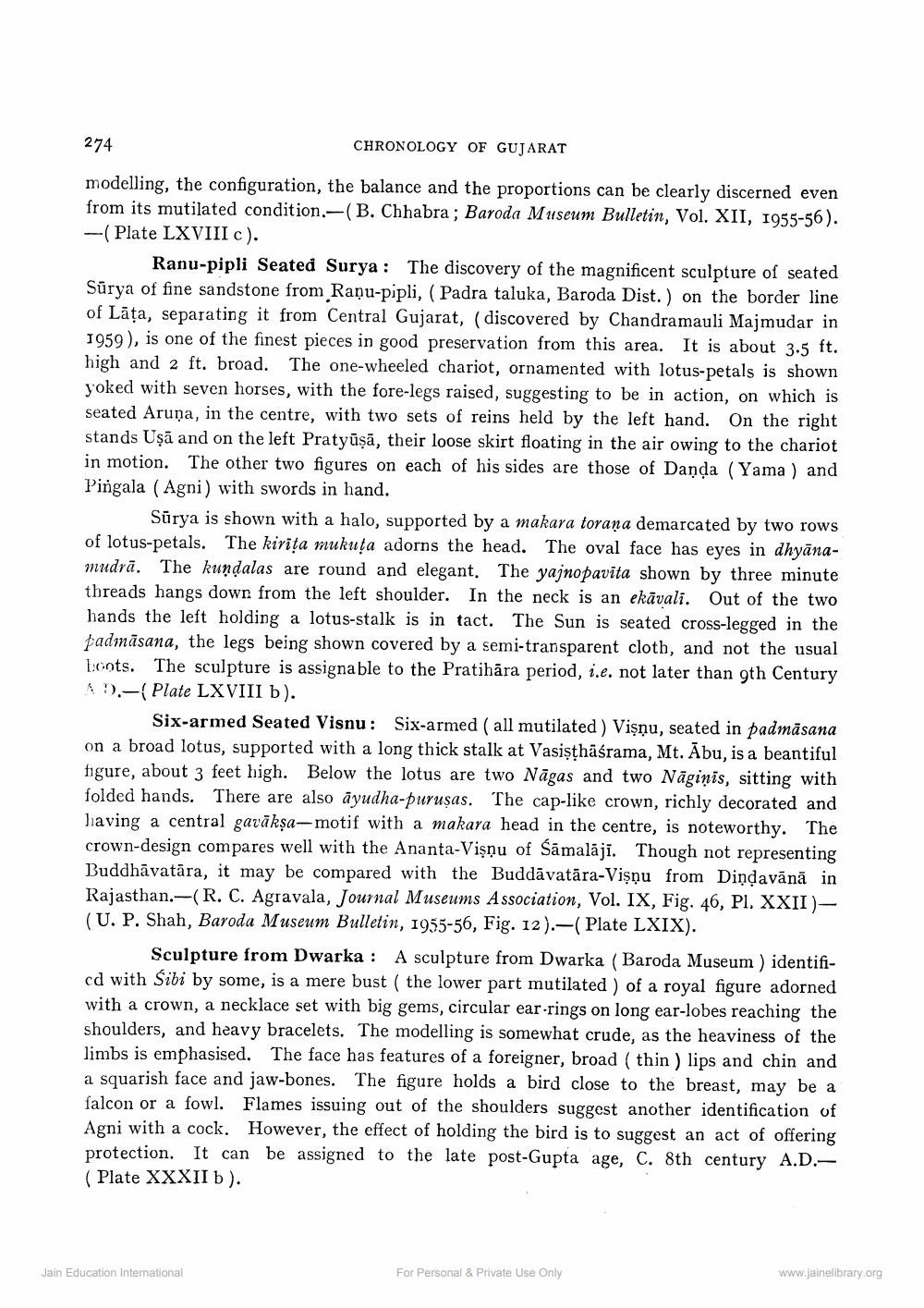________________
274
CHRONOLOGY OF GUJARAT
modelling, the configuration, the balance and the proportions can be clearly discerned even from its mutilated condition.-(B. Chhabra; Baroda Museum Bulletin, Vol. XII, 1955-56). ---( Plate LXVIII C).
Ranu-pipli Seated Surya : The discovery of the magnificent sculpture of seated Sürya of fine sandstone from Raņu-pipli, ( Padra taluka, Baroda Dist.) on the border line of Lāța, separating it from Central Gujarat, (discovered by Chandramauli Majmudar in 1959), is one of the finest pieces in good preservation from this area. It is about 3.5 ft. high and 2 ft. broad. The one-wheeled chariot, ornamented with lotus-petals is shown yoked with seven horses, with the fore-legs raised, suggesting to be in action, on which is seated Aruņa, in the centre, with two sets of reins held by the left hand. On the right stands Uņā and on the left Pratyūņā, their loose skirt floating in the air owing to the chariot in motion. The other two figures on each of his sides are those of Danda (Yama) and Pingala (Agni) with swords in hand.
Sūrya is shown with a halo, supported by a makara toraṇa demarcated by two rows of lotus-petals. The kirița mukuța adorns the head. The oval face has eyes in dhyānamudrā. The kundalas are round and elegant. The yajnopavīta shown by three minute threads hangs down from the left shoulder. In the neck is an ekāvali. Out of the two hands the left holding a lotus-stalk is in tact. The Sun is seated cross-legged in the fadmāsana, the legs being shown covered by a semi-transparent cloth, and not the usual boots. The sculpture is assignable to the Pratihāra period, i.e. not later than 9th Century A!)-(Plate LXVIII b).
Six-armed Seated Visnu: Six-armed (all mutilated ) Vişnu, seated in padmāsana on a broad lotus, supported with a long thick stalk at Vasişthāśrama, Mt. Ābu, is a beantiful figure, about 3 feet high. Below the lotus are two Nāgas and two Nāginis, sitting with folded hands. There are also ayudha-purusas. The cap-like crown, richly decorated and having a central gavākşa-motif with a makara head in the centre, is noteworthy. The crown-design compares well with the Ananta-Vişnu of Sāmalāji. Though not representing Buddhāvatāra, it may be compared with the Buddāvatāra-Vişņu from Dindavānā in Rajasthan.-(R. C. Agravala, Journal Museums Association, Vol. IX, Fig. 46, Pl. XXII)(U. P. Shah, Baroda Museum Bulletin, 1955-56, Fig. 12).-( Plate LXIX).
Sculpture from Dwarka : A sculpture from Dwarka (Baroda Museum ) identificd with Śibi by some, is a mere bust ( the lower part mutilated ) of a royal figure adorned with a crown, a necklace set with big gems, circular ear-rings on long ear-lobes reaching the shoulders, and heavy bracelets. The modelling is somewhat crude, as the heaviness of the limbs is emphasised. The face has features of a foreigner, broad (thin ) lips and chin and a squarish face and jaw-bones. The figure holds a bird close to the breast, may be a falcon or a fowl. Flames issuing out of the shoulders suggest another identification of Agni with a cock. However, the effect of holding the bird is to suggest an act of offering protection. It can be assigned to the late post-Gupta age, C. 8th century A.D.(Plate XXXII b).
Jain Education Interational
For Personal & Private Use Only
www.jainelibrary.org




